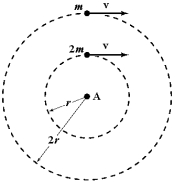Multiple Choice
Two objects of mass m1 = 2m and m2 = m move around a rotation axis A in parallel circles of radii r1 = r and r2 = 2r with equal tangential speeds. As they rotate, forces of equal magnitude are applied opposite to their velocities to stop them. Which statement is correct? 
A) m2 will stop first because it has the larger initial angular velocity.
B) m1 will stop first because it has the smaller radius.
C) m2 will stop first because the torque on it is greater.
D) m1 will stop first because it has the smaller moment of inertia.
E) Both objects will stop at the same time because the angular accelerations are equal.
Correct Answer:

Verified
Correct Answer:
Verified
Q11: A non-uniform 2.0-kg rod is 2.0 m
Q12: A particle whose mass is 2
Q13: A thin rod of mass M and
Q13: A top is set spinning so that
Q16: A pendulum bob of mass m
Q17: The diagram below shows five 20-kg rods
Q18: A solid sphere, a solid cylinder, a
Q19: Two cylinders made of the same
Q20: If L represents angular momentum, I represents
Q50: The net work done in accelerating a